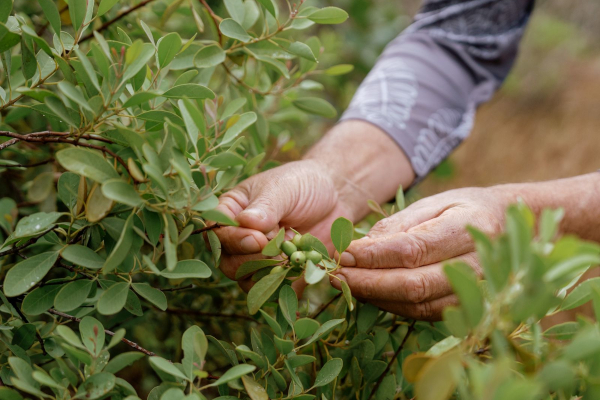Restoring ‘Āina, While Visiting ‘Āina

Whenever Butch Haase sees an ‘iliahi plant in the wild, he makes sure to plant a few seeds. “Each ‘iliahi fruit has a single seed inside it,” he says, squeezing out a dark purple pulp that stains the tips of his fingers. “We found that you can take that seed, find a little location that’s protected, and poke it right into the ground, just one joint of your finger. And it’ll take root and flourish, no need for a nursery!”
‘Iliahi is an endemic Hawaiian species, and it’s just one of a range of native plants being reintroduced at Mokio Preserve, a remote, 1,769-acre preserve at the corner of northwest Moloka‘i that includes savanna, dryland forest, seasonal wetlands, and five miles of rugged shoreline.
Haase, executive director of the Moloka‘i Land Trust (MLT), a nonprofit dedicated to protecting and restoring the island’s land and natural and cultural resources, says, “Hawai‘i is a genetic hotspot like the Galapagos or Madagascar—so isolated that everything has become unique and interdependent. Unfortunately, the introduction of invasive species has also given us the title of endangered species capital of the world.”
To remedy this situation, in 2009, MLT launched the Anapuka Dune Restoration Project, with the goal of converting an arid, invasive-species-covered landscape back into a thriving native ecosystem.
The team started by fencing in 60 acres of the reserve to keep out axis deer and predators such as rats and mongoose, and clearing out kiawe trees so the landscape can be reclaimed with native plant species being grown at their nursery headquarters in Ho‘olehua—aweoweo papa, mau‘u‘aki‘aki, nehe, ‘‘ilima papa, ma‘o, ‘a‘ali‘i, ‘akia, wiliwili, and more.
Since 2021, the trust has been expanding and replacing the original barrier with a new 10-foot-tall, 1.1-mile-long fence that will protect almost 100 acres—a project that was completed just last month.
Right now, MLT is focusing on restoring seven acres of recently cleared land next to the coast, with the goal of planting 6,000 new seedlings by June of this year. This is where student and visitor volunteers are helping make a difference.
“We mostly have volunteers help with planting, mulching, and watering seedlings,” says MLT programs manager Ali Lucas. “It depends on who’s out with us, and we’ll custom tailor the activities to the ability level of the participants. We want them to enjoy themselves. We want them to come back–and keep giving back.”
Lucas says MLT hosted 759 volunteers in 2023, including 34 Neighbor Island residents, 162 from the continent, and 37 international visitors—working a combined total of 40,586 volunteer hours. And, sure enough, many off-island participants have become regulars, returning to volunteer year after year.
MLT’s “voluntourism” efforts are being partially funded by the Hawai‘I Tourism Authority, through its Aloha ‘Aina program, which is administered by the Hawai‘i Community Foundation, and supports community organizations that manage, preserve, and regenerate Hawai‘i’s natural resources and environment.
Haase, who has been working to restore native ecosystems on Moloka‘I since 1995, says he’s excited about being part of a movement to transform Hawai‘I tourism from something often seen as extractive to something restorative to the ‘aina: “The work our visitors get to do is participating in real, tangible movement toward restoring and preserving these native plant species and helping get them to a place where they may not be endangered one day.” Haase has been working to restore native ecosystems on Moloka‘i since 1995 and is excited about being part of a movement to transform Hawai‘i tourism.
Read more Stories of Impact